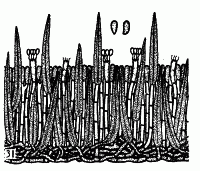|
 Hymenochaete minuscula Hymenochaete minuscula
BiostatusPresent in region - Indigenous. Non endemic
Images (click to enlarge)
Caption: FIG. 31. Hymenochaete minuscula G.H.Cunn. Transverse section x 500; spores x 1000. |
Article: Cunningham, G.H. (1957). Thelephoraceae of New Zealand. XIV. The genus Hymenochaete. Transactions of the Royal Society of New Zealand 85(1): 1-51.
Description: Hymenophore resupinate, annual, membranous, adnate, following surfaces of the host
closely, at first appearing as numerous irregular colonies 1-3 cm across, merging to form
linear areas to 13 x 3 cm. Hymenial surface pallid olivaceous, olivaceous-fuscus, or umber
with a yellow tinge, colliculose, finely areolately creviced; margin thinning out, concolorous,
delicately fibrillose, adnate. Context ferruginous, 50-80 µ thick, composed of 2-3 overlapping
rows of setae embedded in upright hyphae; hyphal system monomitic; generative hyphae 2.5-3 µ diameter, walls 0.25 µ thick, reddish-brown,
branched, septate. Setal layer composed of
1-3 overlapping rows of setae arising from the subhymenium and basal zone; setae projecting
to 35 µ, subulate, 40-65 x 6-8 µ, walls naked, reddish-brown, lumina narrow. Hymenial layer
to 25 µ deep, a close palisade of basidia and paraphyses. Basidia subclavate, 12-16 x 3.5-4 µ,
4-spored; sterigmata slightly arcuate, slender, to 4 µ long. Paraphyses subclavate, slightly
shorter and the same diameter as the basidia. Spores suballantoid, apiculate, 4-5 x 1.5-2 µ,
walls smooth, hyaline, 0.1 µ thick.
Habitat: HABITAT: Effused on bark of dead branches associated with a pocket rot.
Distribution: DISTRIBUTION: New Zealand.
Notes: From the other three species of this section H. minuscula may be separated by the colour of
the strongly colliculose, minutely creviced hymenial surface, thin context, small setae and
spores. The surface to the eye appears pallid olivaceous or yellowish-brown; under a
dissecting microscope it appears umber, velutinate with the small setae, and coated with
yellow granules. The context is scanty and in old specimens contains masses of crystals,
though these are wanting in the type and other well developed specimens. Setae are small,
naked, acute and sometimes bear delicate lateral projections 0.5 µ in length. Spores are
suballantoid with prominent apiculi. The species resembles H. multisetae Burt in several
particulars, differing in the larger setae and differently coloured, strongly colliculose
hymenial surface.
|